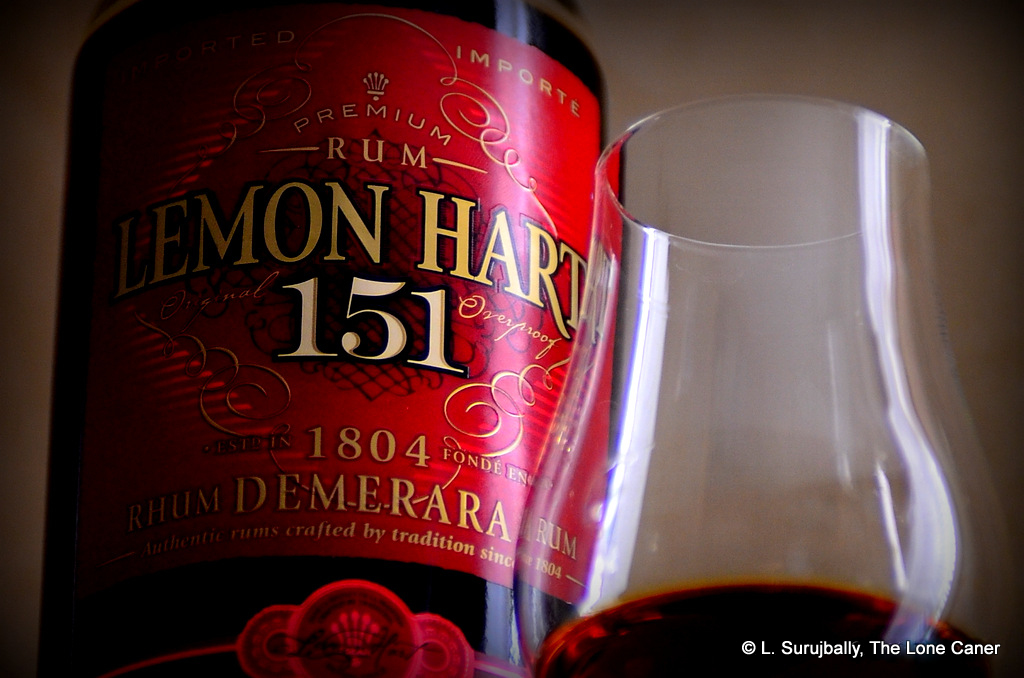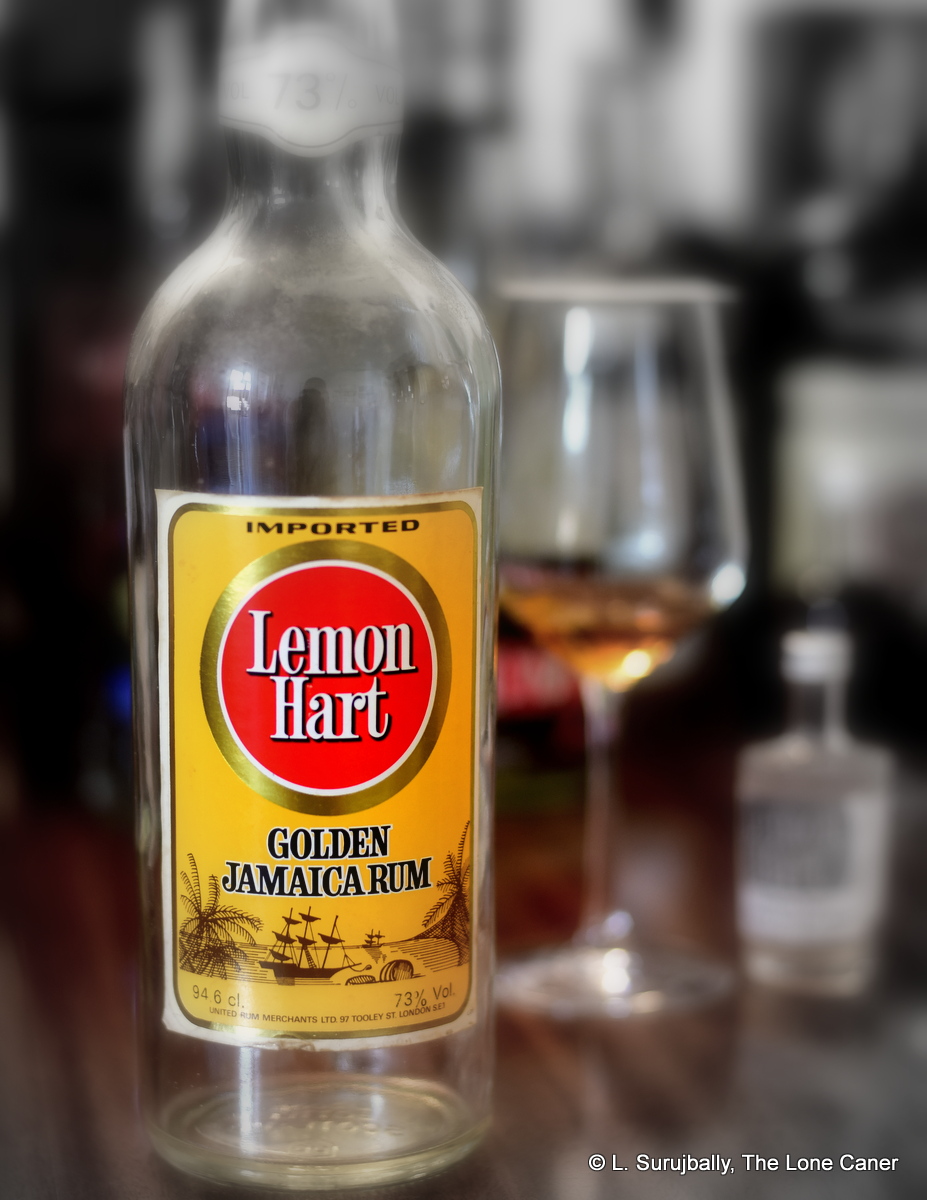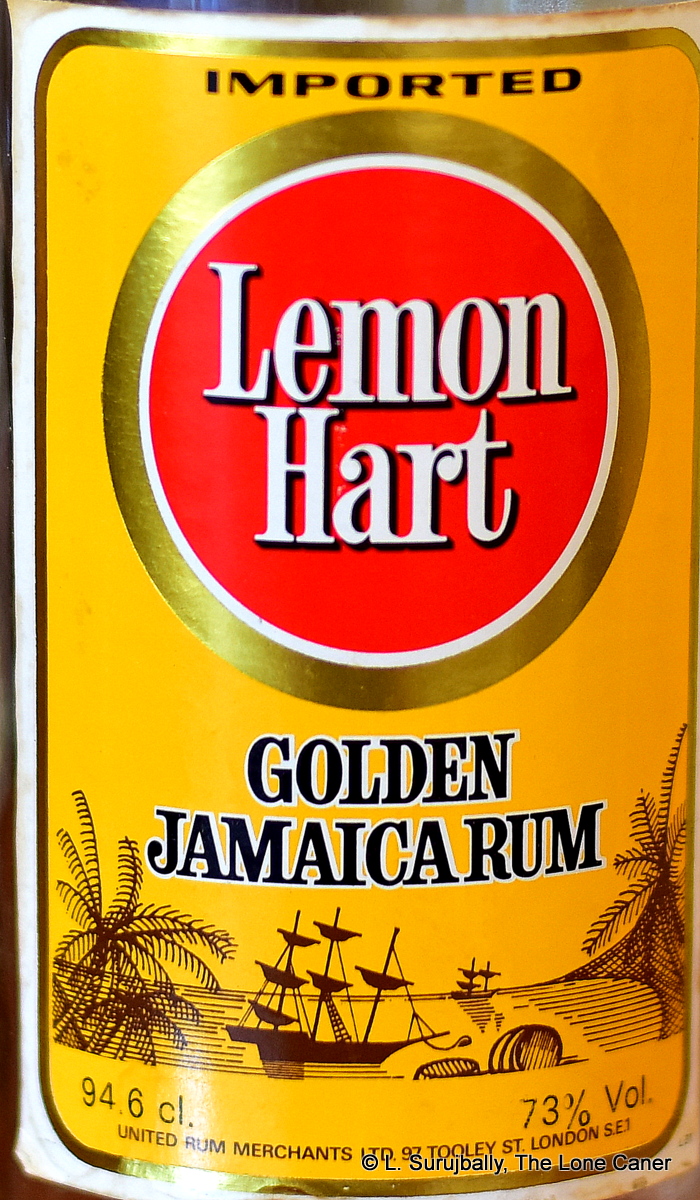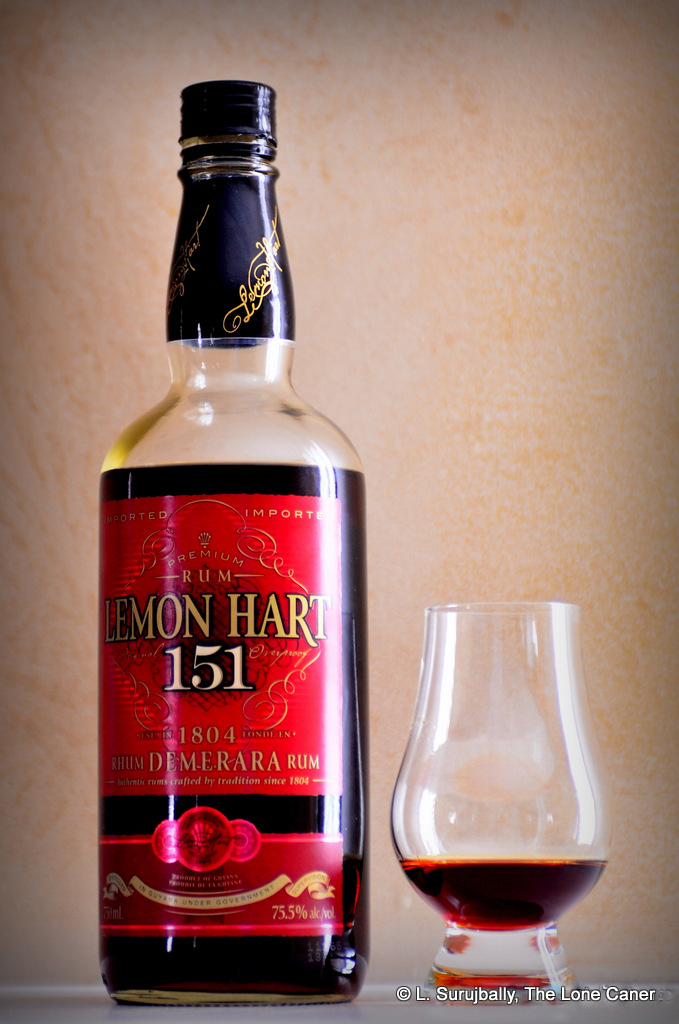This review was posted first on RumConnection in two parts in May 2012. Thanks to Mike Streeter who lends his site to such occasional contributions that exceed his normal article length.
My own, slightly edited (and scored) review which corrected some minor issues and changed the wording a bit, is below. Suffice to say, this is one of those overproofs I really enjoyed. I tried it by itself to write the review, but it’s as a mixer and base that this strong, dark Demerara rum really shines.
It’s big, it’s bad, and it’s tougher than a Brickdam jailbird’s meat ration. It’s 75.5% of tonsil-tearing muscle, a dark brown rum hurricane, and among the meanest, strongest rums available anywhere. Lemon Hart 151 stomps up to you (and maybe over you), casts you a mean, cold-eyed glare, and mutters into your traumatized corpus, “Fear me. Respect me. Honour my eye-watering awesomeness.” In the annals of badassery, this rum will always be one of Sweet Sweetback’s baddest songs.
Overproof rums are a rather astonishing display of rum-on-human violence, and the only drinks I can come up with where participants run the risk of traumatic injury every time they try some — to my knowledge, only industrial ethanol, Brazilian alcool, the SMWS Longpond 9 81.3%, St. Vincent’s Sunset Very Strong (84.5%), Marienburg 90 or Stroh 80 can claim higher alcohol levels. Yet they have their adherents (I am one of them). Yes, you can get drunk faster on ‘em, and yes, they make great cocktails, and yes, for those in penury how can they be beat? – but then they exist on a level beyond that, at a point in space and time where you find ultra-marathoners, HALO parachute jumpers and all those nutso A-types who actually enjoy taking a badass risk every time they try whatever it is they try. This rum is absolutely made for such people. Like any massively overproof rum, it is for the taster an equal mixture of pleasure and pain. Few are the surviving drinkers who do not bend a trembling knee after the fact in a showy, post-trauma, did-I-actually-drink-this? thank-you-Jesus-for-letting-me-live piety. Yet, is it bad for all that? I suggest not.

Coming at me, it sat on my table, dark, squat, ugly with brooding menace and the promise of violence in its dark brown-red stare. In trying it, I didn’t waste my time making nice or taking a sniff immediately, because overproofs usually have enough raw alcohol to stun an ox into catatonia; instead, I let the vapours burn off and the concentrated flavours settle. What I got for my trouble was the spirituous equivalent of a weaponized flatus on steroids – it certainly punched like it. Damn but this was strong. A shade muskier than I would have expected. Chopped fruit…oh, prunes, maybe Christmas black cake. My Aunt Sheila used to make cake that smelled like that, back in Guyana.
In the spirit of reviewing rums, I must confess to a certain masochistic pride at being able to drink any rum, no matter how foul or how strong (I can just see one of my whisky loving bête noires snickering “Isn’t that all of them?“). In this case, I’m glad I did, because the taste of the Lemon Hart isn’t half bad at all for such a hellishly potent overproof. Oh sure, it’s as raw as sandpaper on the palate, and I’d never tell you it was a sipper’s onanistic must-have…but there’s more taste there than you might expect, stronger, more intense. That’s what makes it work: I got a spicy molasses darkness mixed up with burnt brown sugar, bananas, licorice (again), baking spices, and just a sly hint of cinnamon. That last is reaching, though. Lemon Hart 151 is plain-simple, powerfully constructed and straightforward dy-no-mite, and I should not pretend it’s some kind of top end table tipple.
As for the finish, well, I run out of ways to describe it in flowery language, so, to be blunt: raw and harsh and had fumes like a porknocker’s searing effluent…made my eyes water, my throat cringe and my sphincter oscillate. To be fair, even through all that there were weak hints of brown sugar and cloves that cried to their mommies (the cask strength whiskies), as they attempted to emerge through the carving heat of the alcohol, so all was not lost. It’s a mixer for sure, yet surprises are in store for the persistent and slightly deranged who stick with it.
The base liquor for Lemon Hart 151 is made in Guyana (which immediately means DDL) and bottled by Canada’s Newfoundland Liquor Corporation, which also makes the Young’s Old Sam and the Cabot Tower 100 proof Demerara, both heavy, dark molasses-snorting rums that pride themselves in not catering to a connoisseur’s sophistication, and for both of which I have a sneaking affection. Previously Pernod-Ricard had owned the marque before selling it on to a privately held concern, Mosaiq, in 2010, and Lemon Hart does indeed have quite a pedigree….it was itself first marketed in 1804 by Mr. Lehmynn Hart as the rum of choice for Royal Navy when he created the Lemon Hart company in that year, having moved the business he started in the late 1700s from Cornwall to London. Whether they market it as such or not, in the darkness and strength of the current product, you can still see the whispers of that old maritime tradition. (I’ll leave it to you to decide whether Pusser’s, Lamb’s, Favell’s, or Lemon Hart has the right to the crown of “Navy Rum”.)
I remarked once that overproof rums are getting to the stage that they can seriously be considered drinks in their own right as opposed to seeing them as only Tanti Merle’s black cake ingredients or mixologists’ wet dreams. Unfortunately, like single digit rums or popular blends, they labour under a cloud of perceptive disapproval, often thought of as no more than poor student’s tipples or backdam stand-bys for the bushmen I used to drink with in my youth. I mean, can you honestly see a guy who waxes rhapsodic over the English Harbour 25 year old buy one of these bad boys? Lemon Hart 151 for sure has little couth, zero class, laughs at complexity, and does not give a good goddamn about any of that (or your tonsils, so be warned). What it cares about is giving you a concentrated burst of simple, powerful flavours wrapped up in a sheet of such stunning white lightning that, when your DNA settles back from being devolved and you can speak coherently again, you actually can consider the rum as being…well…kinda good.
(#107. 79.5/100)
Other Notes
- A 2024 video recap is here.
- This is the reissued Lemon Hart 151 which only started to hit shelves in the last year or so and lacks the 1.5% Canadian rum the previous iteration had…it’s not the original rum people may be more familiar with, which did have that inclusion.
- For additional details on the history and development of 151 overproof rums, this article provides all the background

 Palate – Even if they didn’t say so on the label, I’d say this is almost completely Guyanese just because of the way all the standard wooden-still tastes are so forcefully put on show – if there was anything else in there, it was blattened flat by the licorice, plums, prunes and cloves bearing down like a falling Candy of the Lord. It remains musky, deep and absolutely massive right to the end, and even adds some salted caramel ice cream, Danish butter cookies, almonds, cloves and crushed nuts to the mix, plus maybe a bit of citrus.
Palate – Even if they didn’t say so on the label, I’d say this is almost completely Guyanese just because of the way all the standard wooden-still tastes are so forcefully put on show – if there was anything else in there, it was blattened flat by the licorice, plums, prunes and cloves bearing down like a falling Candy of the Lord. It remains musky, deep and absolutely massive right to the end, and even adds some salted caramel ice cream, Danish butter cookies, almonds, cloves and crushed nuts to the mix, plus maybe a bit of citrus. Rumaniacs Review #107 | R-0688
Rumaniacs Review #107 | R-0688 Palate – Waiting for this to open up is definitely the way to go, because with some patience, the bags of funk, soda pop, nail polish, red and yellow overripe fruits, grapes and raisins just become a taste avalanche across the tongue. It’s a very solid series of tastes, firm but not sharp unless you gulp it (not recommended) and once you get used to it, it settles down well to just providing every smidgen of taste of which it is capable.
Palate – Waiting for this to open up is definitely the way to go, because with some patience, the bags of funk, soda pop, nail polish, red and yellow overripe fruits, grapes and raisins just become a taste avalanche across the tongue. It’s a very solid series of tastes, firm but not sharp unless you gulp it (not recommended) and once you get used to it, it settles down well to just providing every smidgen of taste of which it is capable.

